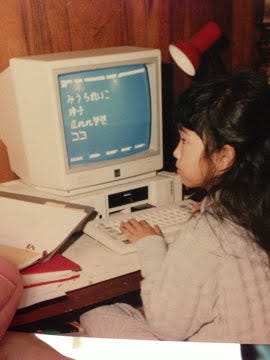Era of Mass Cognition
From Compute and Connectivity to Cognition: The Next Great Sea Change

Throughout history, technological inflections have fundamentally altered how we live and work. In venture capital, we're constantly searching for inflections—external forces that propel startups beyond what they could achieve through effort alone. As my partner Mike Maples defines it, an inflection is "an event that creates the potential for radical change in how people think, feel, and act."
These inflections can be technical, regulatory, or societal in nature. But once every generation, we witness something even more profound: a technological sea change that transforms everything in its path. I don’t think I’m alone in feeling like we are in the midst of one today with AI but I thought I’d set a little bit of context with two others I’ve witnessed in my lifetime and how this one compares…
The Three Great Sea Changes
1. Mass Compute (1980s-1990s)
The sea change of Mass Compute began with personal computers entering our homes and classrooms. I still recall when my father came home in 1984 with an IBM PC Junior. It gave us access to word processors, spreadsheets, flight simulators, games like Frogger, and for me the chance to experiment with creating fonts:

What seemed revolutionary then—the ability to run software on personal machines — feels quite ordinary today. The power of compute was democratized widely into the home. By the end of the 1990s more than half of American households owned a personal computer. Falling prices made computers more accessible and in turn, Windows 95 made computers more accessible to non-technical users. Software like Quicken and Office demonstrated the power of software over pen and paper. Surprisingly, this era of mass compute was not dominated by the companies that gave us access to computers. It was instead software that captured value in this era and of course, Microsoft dominated the value capture in this period.
2. Mass Connectivity (2000s-2010s)
Before mass connectivity transformed our world, social and informational friction defined daily life. A household typically shared a single landline (one phone number for the whole family). Research required physical pilgrimages to libraries, where knowledge remained locked in encyclopedias that could only be accessed by one person at a time, updated once every few years whenever a new edition could be purchased. Finding friends on a college campus meant wandering aimlessly, hoping serendipity would bring your paths together.
The introduction of internet browsers transformed this landscape almost overnight, followed by waves of broadband penetration, smartphone proliferation, and social network adoption. Each innovation reduced friction in how we connected—to information, to services, to each other. This wave crested as I was graduating college, defining my early professional life.
What made mass connectivity revolutionary wasn't just the technical infrastructure but how it fundamentally altered social behavior. The ability to access anything, anywhere, anytime shifted our expectations about availability and responsiveness. The always-on culture we now complain about began as a miracle of instantaneous connection.
Mass connectivity created four transformative linkages, all mediated through software:
- People connecting to information (search engines, Wikipedia, e-commerce)
- People connecting to networks (broadband, cellular)
- People connecting to computing resources (cloud services, SaaS)
- People connecting to other people (messaging, social media, professional networks)
This networked world we now take for granted enabled something even more valuable: the systematic capture of human behavior at scale. Every click, search, and social connection generated data that became the new oil of the digital economy. Users and their behaviors became the product itself, creating unprecedented value.
The resulting network effects birthed data superpowers like Amazon, Google, Meta, and Netflix—companies that mastered the art of leveraging behavioral data to personalize experiences and target offerings with uncanny precision. Interestingly, mass connectivity didn't ultimately reward the infrastructure pioneers like Netscape, Comcast, or Nokia, but rather those who built compelling services atop that infrastructure.
3. Mass Cognition (2020s)
Today, we're witnessing the dawn of mass cognition, a truly magical transformation 60 years in the making. The field of AI celebrated its 60th anniversary at Stanford recently, reminding us that this "overnight success" has been built on decades of research and incremental progress.
Unlike previous technological waves, mass cognition involves models that possess broad understanding across various domains—something that seemed impossible just a few years ago. The models we're seeing today stand in stark contrast to the single-purpose models I worked with during my PhD studies at Stanford.
While Mass Compute democratized processing, Mass Connectivity democratized access. Today, Mass Cognition democratizes intelligence itself.
This democratization of cognition is reshaping our relationship with technology:
- From tools to collaborators. Software isn’t just a passive instrument but an active partner in thought.
- From skill-gated to open access. Expertise once required years of training; now anyone can summon sophisticated capabilities with a sentence.
- From narrow tasks to open-ended reasoning. Machines no longer just calculate—they infer, hypothesize, and create.
The cognitive substrate of society is shifting, and with it, the kinds of companies and behaviors that will dominate.
What Makes Mass Cognition Interesting
Language as the API to Humans
Perhaps the most profound revolution in the mass cognition era is the inversion of the human-computer interface paradigm that has dominated computing for over 70 years. Since the earliest days of computing, humans have been forced to learn machine languages—whether through punch cards, command lines, GUIs, or touch interfaces. We've continuously adapted our communication to accommodate the computer's limitations. This meant that if we wanted to unleash the true power of computation, we had to become bilingual: fluent not just in human intent but in the rigid syntax machines demanded. Software engineers were our tireless translators mediating between messy human desire and unforgiving machine precision.
But for the first time, that balance is actually shifting. We can now use our own language - the most ancient, evolved and universal human interface - to communicate directly with compute. Remarkably, compute will also communicate back!
Language is more than words. It is how humans encode intent, context, and meaning. It is the compression algorithm for our desires and our reasoning. This is what makes language the true API to humans:
- It captures intent without requiring precision.
- It embeds context implicitly (assumptions, cultural norms, prior knowledge).
- It is universal—every human, regardless of training, has access to it.
Until now, machines couldn’t handle this kind of messy, probabilistic input. They demanded exactness. But large language models thrive on it. For the first time, machines are meeting us on our terms. Compute now has an API to humans.
Why This Matters
- Accessibility and Expansion of Participation. Anyone who can speak or write now has access to advanced computation. This collapses the gap between “users” and “builders.” We’ve seen this firsthand in portfolio companies like Roo.vet, where customer success representatives felt confident enough to submit pull requests over Slack based on the product experiences they were seeing with customers. That kind of direct participation from non-technical roles was unimaginable a few years ago. It raises big questions about how the product role itself may evolve, but it’s already creating exciting new pathways for ideas to surface and be acted upon.
- Speed of Innovation. Translation layers like programmers and UI designers don’t disappear, but they’re no longer bottlenecks. That accelerates experimentation and lowers the cost of trying. Back in 2008, when we launched the Lean Launchpad class at Stanford, we pushed students to prototype products quickly and put them in front of customers. It was easier to run that class out of the engineering school, where students had the technical skills to build. But today, the expectation should be that students across disciplines can participate by actually building and iterating on prototypes every week. The compounding impact of this faster learning cycle will be remarkable.
- Reconfiguration of Value Chains. If language is the interface, then the companies that can best capture, interpret, and act on human intent will dominate. It won’t be the prettiest UI or the fastest chip—it will be whoever understands people best. One of our portfolio companies, SmarterDX, developed revenue cycle management tools that unlocked new revenue for hospitals by uncovering implicit coding opportunities buried in health records. By understanding doctors’ intent better than anyone else, they created massive value—leading to an exit of more than $1B in less than four years.
Conclusions
Each technological sea change has redrawn the map of who participates, where value accrues, and what becomes possible. Mass Compute put a computer in every home. Mass Connectivity put the world’s knowledge and networks at our fingertips. Mass Cognition puts intelligence itself within reach of anyone who can express intent. As I’ve told my kids - it massively empowers the order makers of the world but threatens order takers. This is more than the next platform shift—it is a reconfiguration of the relationship between humans and machines. The companies that rise in this era will not simply build faster processors or prettier interfaces; they will be the ones that best understand, interpret, and serve human intent. It will massively reward people who have great judgment and intuition. For founders, builders, and investors alike, the challenge is clear: the API to humans has finally opened—what will you build with it?

.jpg)